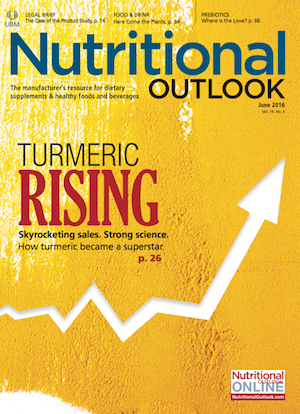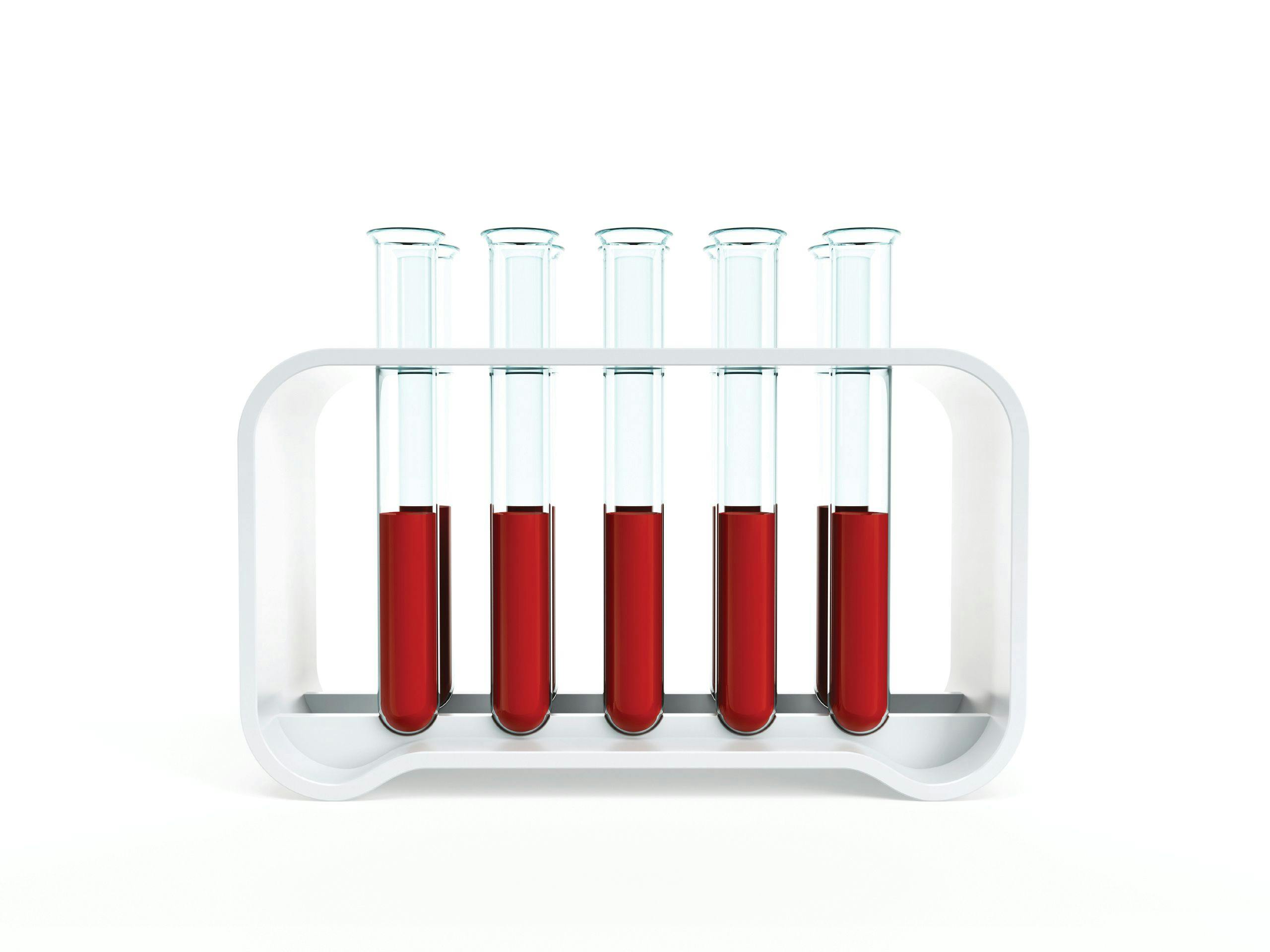Turmeric Rising: Turmeric and Curcumin Research Is Hot
Turmeric is the darling of the natural products market. What have we learned lately about turmeric and its active constituent, curcumin?
Photo © iStockphoto.com/Prashant ZI. Edited by Quinn Williams

Turmeric, the herb du jour, has long outgrown its reputation as merely a flavorful spice. Promising clinical data plus powerful marketing campaigns heralding turmeric’s antioxidant and anti-inflammatory health benefits have turned this rhizomatous plant into a star. The result? Sales are up-way up.
In both 2013 and 2014, turmeric was the number one bestselling herbal ingredient in U.S. natural and health food stores, with more than 30% sales growth in 2013–2014 alone, according to the American Botanical Council’s (Austin, TX) annual HerbalGram U.S. herbal dietary supplement sales report. HerbalGram’s report on 2015 herbal sales isn’t out yet, but if we were to bet, we’d anticipate similarly stellar results.
Scientists and consumers are now simply fascinated by what turmeric and its active constituent, curcumin, can do for health. But what exactly is all the fuss about? Turmeric’s claim to fame is a seemingly unending roster of emerging studies pointing to potential, wide-ranging applications for the golden spice and its extracts. Let’s take a look at some of the latest health indications under investigation. All research described herein concerns the turmeric species Curcuma longa, unless otherwise noted.
Exercise Recovery
Thanks to its anti-inflammatory action, curcumin may be a promising exercise recovery aid. Researchers at the University of North Texas reported that a curcumin extract reduced inflammation markers in adult subjects after exercise.1
Study participants who consumed 400 mg/day of the Longvida brand of curcumin extract experienced a reduced increase in creatine kinase (CK) and inflammatory cytokines after a leg press exercise, compared to a placebo group. Among the curcumin group, researchers observed significantly smaller increases in CK (-48%), TNF-α (-25%), and IL-8 (-21%).
Interestingly, despite a smaller rise in inflammatory markers, researchers noted that subjects didn’t necessarily feel any improvement in muscle soreness, based on questionnaires the subjects completed. But, according to Longvida’s supplier, Verdure Sciences (Noblesville, IN), this is not unusual. “Inconsistencies in a reduction in soreness are expected, as soreness is a very subjective measurement,” says Sonya Cropper, vice president of marketing and innovation. That may also explain inconsistencies in soreness measures in previous studies on curcumin and exercise.
Muscle soreness may not necessarily impact function, but the North Texas study researchers noted that muscle inflammation “directly interferes with muscle function (i.e., reduced range of motion, reduced contractile ability, etc.),” even if the athlete does not immediately perceive the inflammation.
Here’s where curcumin may help. One primary way by which curcumin lowers body inflammation is by inhibiting COX-2, an enzyme that triggers inflammation. (Non-steroidal anti-inflammatory drugs are used for the same purpose, by the way.) A significant amount of scientific literature has already outlined the COX-2 effect, and now other proposed mechanisms for curcumin’s anti-inflammatory properties are under investigation.
Elsewhere in the sports market, OmniActive Health Technologies (Morristown, NJ) is assessing its CurcuWin curcumin extract for effects on arterial stiffness after exercise.2 Lynda Doyle, OmniActive’s vice president of global marketing, says this will be the first public study on curcuminoids and arterial stiffness. The results could complement results of another OmniActive study, presented in April, which found the company’s curcumin significantly increased flow-mediated dilation (the ability of blood vessels to expand and contract) in adults after exercise.3
Reduced arterial stiffness and increased flow-mediated dilation may also translate to significantly better heart health outcomes. According to Doyle, a mere 1% increase in flow-mediated dilation reduces one’s heart disease risk by 9%–17%. In OmniActive’s study, flow-mediated dilation increased by a mean 2.8%.
STORY CONTINUES ON PAGE 2
Healthy Skin
Just as inflammation harms a human’s inner organs and muscles, it can also hurt what’s on the outside-the skin. Enter curcumin. Indena SpA (Milan, Italy) funded a 2015 study on its Meriva curcumin and psoriasis improvement. In the study, curcumin was found to enhance the effect of topical steroids.4
In addition, two recently completed studies involving the National Cancer Institute will soon inform the public of any potential benefit of curcumin on radiation-induced dermatitis.5,6 The same curcumin extract used in these studies, Curcumin C3 Complex from Sabinsa Corp. (East Windsor, NJ), appeared to reduce this kind of dermatitis in a 2013 study in breast cancer patients.7
Brain Health
There is also much more to explore between curcumin and brain health. A number of contemporary curcumin studies are focusing on Alzheimer’s disease, with early data hinting that curcumin can help promote the elimination of amyloid protein plaques from the brain.
“Alzheimer’s is thought to be due in part to the accumulation in the brain of protein tangles or plaques, which not only disrupts the transmission of nerve signals but also ends up ‘choking’ the nerve cells,” says Verdure Sciences’ Cropper, whose company’s Longvida extract has been studied in several trials related to this theory. In addition, an ongoing study on Theracurmin curcumin from Theravalues Corp. (Tokyo) is utilizing brain scans of elderly subjects to see how this particular curcumin extract may affect the presence of these protein tangles over time.8
Long-term environmental stressors can also influence the health of the brain, says Anurag Pande, PhD, Sabinsa’s vice president of scientific affairs. Over time, Pande says, such factors may activate or deactivate certain genes, which may trigger development of diseases like schizophrenia. Fortunately, curcumin may potentially affect epigenetic mechanisms related to inhibition of various diseases such as schizophrenia, he says. Safety and efficacy studies are already underway to assess curcumin’s usefulness alongside antipsychotic drugs,9 Alzheimer’s medications,10 and antidepressants.11 Adults and children12 are part of the exploration, and exercise13 is involved in some protocols.
Cancers
Cancers are associated with symptoms of severe inflammation. For this reason, researchers are increasingly considering curcumin’s potential to support cancer therapy.
Notable ongoing and recently completed curcumin studies on cancer include those on Meriva curcumin extract from Indena, as well as BCM-95 curcumin extract from Arjuna Natural Extracts Ltd. (Kerala, India) and Dolcas Biotech LLC (Landing, NJ). Multiple other curcumin suppliers are also engaged in the field. Projects are exploring the safety of curcumin extracts when used by cancer patients, potential harmonization between curcumin and chemotherapy drugs, and changes in overall quality of life with curcumin use. Early data even suggest that curcumin might have an effect on tumor growth. With some luck-and pending significant positive clinical results, of course-the application of curcumin in cancer therapy could be widespread, with potential benefits for patients suffering from prostate cancer,14 colon cancer,15,16 and endometrial cancer.17
STORY CONTINUES ON PAGE 3
Decontamination
The golden spice and its derivative curcumin appear to be antibacterial, as evidenced by recent studies on their effects on pathogens. In these studies, turmeric and curcumin extracts have suppressed growth of undesired food-borne bacteria such as E. coli and S. aureus and bacteria that are transmitted in healthcare settings. Efficacy may depend on the curcumin extraction method18-for instance, whether extracted with water versus ethanol-and efficacy may even improve with a fermented turmeric extract.19 One recent study even found an antibacterial effect with a mere crude turmeric paste.20
Potential applications for curcumin as an antibacterial agent may include using it as a feed additive21 for infected livestock, or even sprinkling it on vegetables and meats intended for human consumption.22 A recent study on the NovaSol curcumin extract from Frutarom Ltd. (Haifa, Israel) took the latter approach, using curcumin to decontaminate cucumber, pepper, and chicken meat for up to 48 hours.
Turmeric isn’t popularly used as an antibacterial agent yet, but it’s already approved as a food additive for coloring purposes in the United States and the European Union.
Oral Care
Turmeric’s antibacterial quality can also apply to oral care. Recent studies show antibacterial benefits when curcumin was applied directly to teeth23 or mixed in media cultivated with periodontal pathogens.24
Curcumin’s anti-inflammatory properties may also lend other oral benefits. For instance, researchers are exploring whether a turmeric mouth rinse may help relieve chemotherapy-associated mucositis.25
The current market for turmeric-based oral care is limited, but more positive data could grow the herb’s popularity in retail mouthwash and toothpaste products.
Bioavailability
On a final note, while promising research has been published on turmeric and its extracts, manufacturers need to remember that not all turmeric extracts are the same. The type, bioavailability, absorption, metabolism, and systemic elimination of turmeric nutrients can differ vastly from one supplier’s ingredient to another. In fact, most curcumin suppliers claim that outcomes in certain studies were only possible thanks to their unique curcumin delivery system and its bioavailability benefits. It’s always best to check with individual turmeric and curcumin suppliers to consider published science on their own particular raw materials and extracts, as well as other pros and cons that might motivate a purchase.
STORY CONTINUES ON PAGE 4
Sidebar: Curcumin Product Trends
Ever since science on turmeric and curcumin picked up, manufacturers have increasingly sold turmeric as more than a standalone spice. Now well established in the dietary supplement market, turmeric is taking a turn into ready-to-drink (RTD) products.
In beverages, turmeric has progressed from turmeric milk, a traditionally consumed Indian drink, to a range of modern RTD products containing the spice and/or its extract. Still, there are obvious limitations to the adaptability of turmeric to beverages, depending on the ingredient you use. Turmeric’s textural properties, orange–yellow color, and pungent spiciness don’t always harmonize with the liquid format or with other ingredients in RTD beverages.
When challenges arise, a different kind of turmeric might do the job. Curcumin expert Sabinsa Corp. (East Winsor, NJ) is one supplier breaking big ground for curcumin in beverages. The company recently introduced UC3 Clear, a soluble Curcuma longa ingredient that ultimately prevents residual curcumin from settling at the bottom of a beverage bottle.
You could also try an entirely different turmeric species altogether. Temple Turmeric, which retails more than a dozen different RTD turmeric beverages, says it is the first to market an RTD beverage with Curcuma mangga, also known as mango ginger or white turmeric. This species of turmeric may not contain as many curcuminoids as C. longa,26 but it’s not without its own health benefits; plus, its fruity aroma and flavor and lighter color suit beverages especially. The remainder of Temple Turmeric’s drink line is formulated with the trademarked Hawaiian Oana Turmeric, a domestic variety of C. longa that has deep color but is sweeter to taste than conventional Indira yellow turmeric.
According to Temple Turmeric founder and CEO Daniel Sullivan, another trend to watch out for in the turmeric RTD space is a combination of ingredients for gut health. Fermented ingredients, apple cider vinegar, and ginger can complement turmeric’s flavor and function.
Turning back to the supplements space, while turmeric pills and powders are marketable on their own, manufacturers are also combining turmeric with other complementary nutrients. Omega-3 supplement specialist Nordic Naturals just launched a soft gel product that marries fish oil and curcumin. Other omega-3 retailers are promoting similar formulas, with the presumed intention of increasing the anti-inflammatory potential of their products.
Also read:
Google Calls Turmeric a Rising Star
U.S. Herbal Supplement Sales Up 6.8% in 2014
Soluble Curcumin May Have Big Implications for Turmeric Beverages
Curcumin Reduces Symptoms of Exercise-Induced Muscle Damage, Study Suggests
Turmeric: 2015 Ingredients to Watch for Food, Beverage, Supplements
References:
- McFarlin BK et al., “Reduced inflammatory and muscle damage biomarkers following oral supplementation with bioavailable curcumin,” BBA Clinical, vol. 5 (June 2016): 72–78
- ClinicalTrials.gov Identifier: NCT02281981
- Oliver JM et al., “Novel form of curcumin improves endothelial function in young, healthy individuals,” The FASEB Journal, vol. 30, no. 1, supplement lb340 (April 2016)
- Antiga E et al., “Oral curcumin (Meriva) is effective as an adjuvant treatment and is able to reduce IL-22 serum levels in patients with psoriasis vulgaris,” BioMed Research International. Published online May 18, 2015.
- ClinicalTrials.gov Identifier: NCT01246973
- ClinicalTrials.gov Identifier: NCT01042938
- Ryan JL et al., “Curcumin for radiation dermatitis: a randomized, double-blind, placebo-controlled clinical trial of thirty breast cancer patients,” Radiation Research, vol. 180, no. 1 (July 2013): 34-43
- ClinicalTrials.gov Identifier: NCT01383161
- ClinicalTrials.gov Identifier: NCT01875822
- ClinicalTrials.gov Identifier: NCT00099710
- ClinicalTrials.gov Identifier: NCT01022632
- ClinicalTrials.gov Identifier: NCT01928043
- ClinicalTrials.gov Identifier: NCT01811381
- ClinicalTrials.gov Identifier: NCT01917890
- ClinicalTrials.gov Identifier: NCT02724202
- ClinicalTrials.gov Identifier: NCT01859858
- ClinicalTrials.gov Identifier: NCT02017353
- Gul P et al., “Antimicrobial activity of turmeric extract and its potential use in food industry,” Journal of Food Science and Technology, vol. 52, no. 4 (April 2015): 2272-2279
- Mohamed SA et al, “Influence of solid state fermentation by Trichoderma spp. on solubility, phenolic content, antioxidant, and antimicrobial activities of commercial turmeric,” Bioscience, Biotechnology, and Biochemistry, vol. 80, no. 5 (May 2016): 920-928
- Afrose R et al., “Antibacterial effect of Curcuma longa (turmeric) against Staphylococcus aureus and Escherichia coli,” Mymensingh Medical Journal, vol. 24, no. 3 (July 2015): 506-515
- Varmuzova K et al., “Curcuma and Scutellaria plant extracts protect chickens against inflammation and Salmonella Enteritidis infection,” Poultry Science, vol. 94, no. 9 (September 2015): 2049-2058
- Tortik N et al., “Photodynamic decontamination of foodstuff from Staphylococcus aureus based on novel formulations of curcumin,” Photochemical & Photobiological Sciences, vol. 13, no. 10 (October 2014): 1402-1409
- Dhariwal NS et al., “A comparative evaluation of antibacterial effectiveness of sodium hypochlorite, Curcuma longa, and Camellia sinensis as irrigating solutions on isolated anaerobic bacteria from infected primary teeth,” Journal of the Indian Society of Pedodontics and Preventive Dentistry, vol. 34, no. 2 (April–June 2016): 165-171
- Izui S et al., “Antibacterial activity of curcumin against periodontopathic bacteria,” Journal of Periodontology, vol. 87, no. 1 (January 2016): 83-90
- ClinicalTrials.gov Identifier: NCT02300727
- Nahak G et al., “Evaluation of antioxidant activity in ethanolic extracts of five curcuma species,” International Research Journal of Pharmacy, vol. 2, no. 12 (2011): 243-248






















